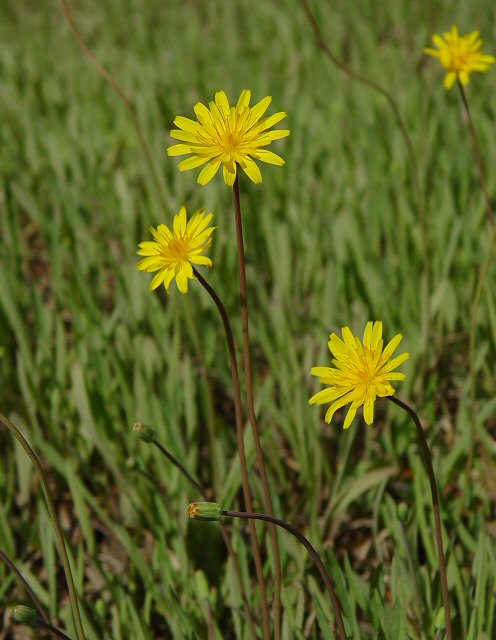Krigia dandelion (L.) Nutt.
Potato Dandelion

Native
CC = 6
CW = 3
MOC = 45
© DETenaglia
Krigia dandelion (L.) Nutt.Potato Dandelion | |
 |
Native CC = 6 CW = 3 MOC = 45 |
© DETenaglia |
|
Family - Asteraceae/Cichorieae Habit - Perennial forb, mostly with fibrous roots and slender, sometimes nearly vertical rhizomes producing 1 or a few globose to ovoid, potato-like tubers 5-15 mm in diameter. Stems - Scapose, ascending to erect, to 50 cm, 1 to few, unbranched, glabrous or sparsely to moderately pubescent with spreading, gland-tipped hairs, especially toward the tip. All parts of the plant with milky sap.
Leaves - All basal, sessile or with a short to less commonly long, winged petiole. Leaf blades 2-25 cm long, linear to narrowly lanceolate or narrowly oblanceolate, entire, wavy, toothed, or shallowly to deeply pinnately lobed, the teeth or lobes spreading, broadly triangular and pointed or occasionally oblong and rounded, the leaf tip rounded to more commonly sharply pointed, the surfaces usually glabrous except at the very base, usually glaucous.
Inflorescence - Single flowering head terminating the flowering scape. Heads - Ligulate. Receptacle flat, naked. Involucre to 1.5 cm long. Involucral bracts 14-16 in a single series, 10-15 mm long, narrowly lanceolate to narrowly oblong-lanceolate, flat (not keeled), glabrous, withering and becoming reflexed with age.
Florets - Ligulate florets 25-35, fertile. Corollas 12-25 mm long, lemon yellow to orangish yellow, those of the outer florets sometimes purplish-tinged on the outer surface. Pappus of 25-45 bristles and 10-15 short, inconspicuous scales, the bristles 5-8 mm long, white or nearly so to very light tan, the scales 0.5-1.0 mm long, irregularly lanceolate to oblanceolate, transparent but sometimes with a darker central line or stripe. Corolla tube to 6 mm long, whitish, glabrous to sparse pilose. Ligule yellow-orange, to +1.5cm long, +2.5mm broad, sparse pilose externally, glabrous internally, 5-toothed at the apex.
Fruits - Achenes 2.2-2.7 mm long, more or less cylindrical (slightly expanded at the tip, slightly tapered at the base), more or less circular in cross-section, with 12-15 blunt, broad ribs, these microscopically roughened or barbed, reddish brown to dark brown. Flowering - April - June. Habitat - Prairies, glades, bluffs, sandy fields, open woods, roadsides. Origin - Native to the U.S. Lookalikes - Other species of Krigia, most notably K. biflora. Broadly, many other species within the Cichorieae tribe of the Asteraceae, such as species of Hieracium, Sonchus, Hypochaeris, Taraxacum, and others. Other info. - This handsome species can be found in Missouri mostly in counties south of the Missouri River, and beyond Missouri throughout most of the southeastern U.S. It is fairly easily recognized by the single, largish yellow flowering heads, scapose habit with all leaves in a basal rosette, and blue-green, glaucous herbage. A diagnostic indicator of this species is the small tuber(s) attached to the roots, but digging up the plant to check for this feature is discouraged. Photographs taken somewhere in North Carolina, 4-26-03, and in Hunter, AL., 4-9-05 (DETenaglia); also at Daniel Boone Conservation Area, Warren County, MO, 5-17-2008, southeast of Crane Lake, Iron County, MO, 4-23-2012, and at Bismark Conservation Area, Iron County, MO, 5-12-2015 (SRTurner). |